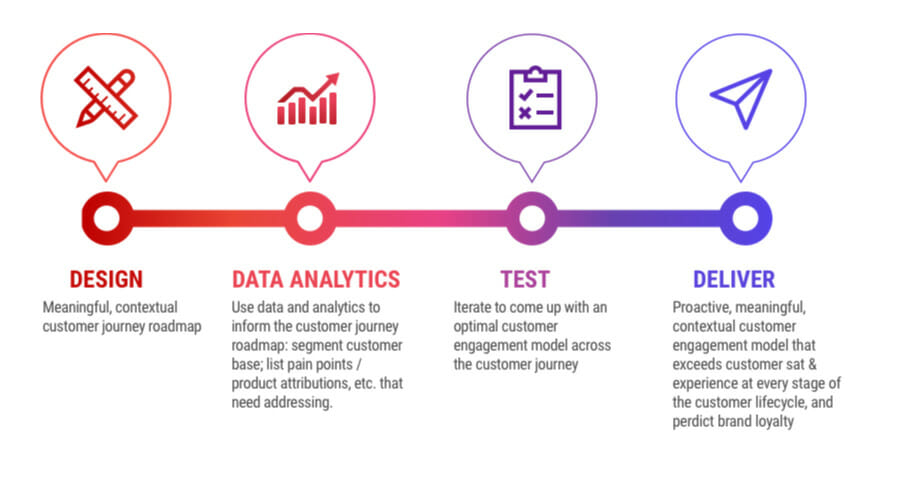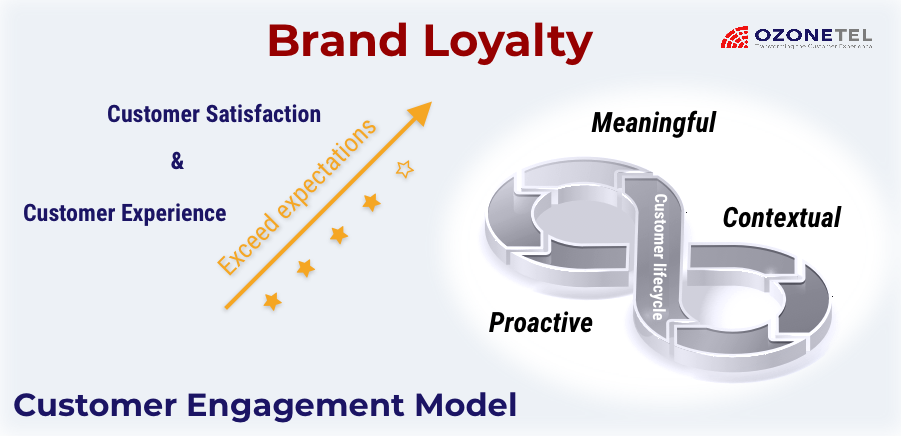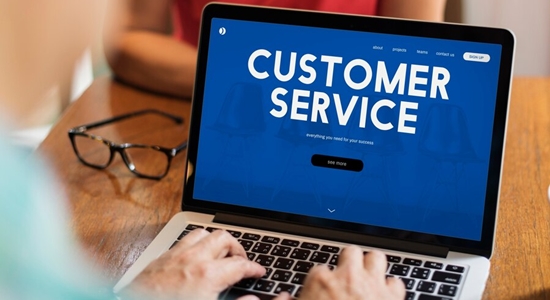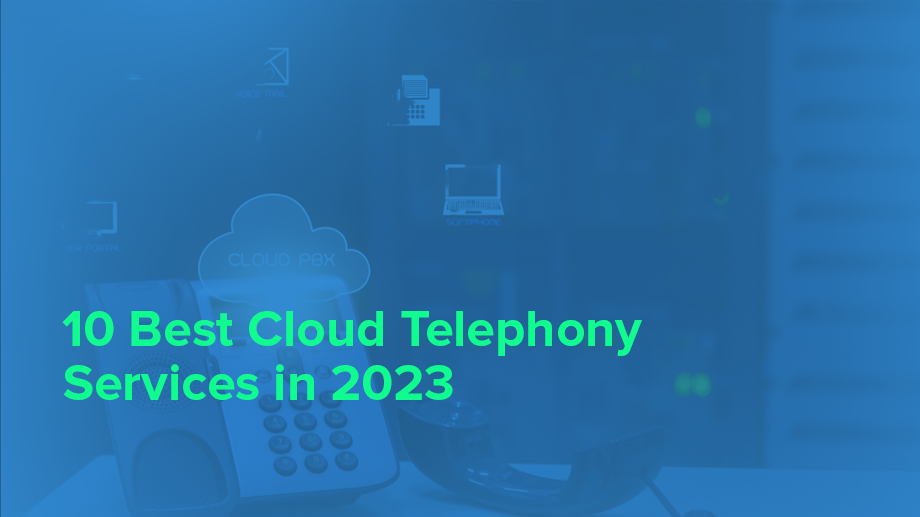- Resources
- A Comprehensive Guide to Customer Engagement Model
A Comprehensive Guide to Customer Engagement Model

In this article, we will explore:
- 1. What Are Customer Engagement Models?
- 2. Why Do You Need a Customer Engagement Model?
- 3. Choosing The Best Customer Engagement Model: Factors to Consider
- 4. Models to Boost Customer Engagement
- 5. Strategies to Create an Optimal Customer Engagement Model
- 6. Sucess Stories & Examples of Good Customer Engagement
- 7. Enhanced Customer Engagement Model Toolkit
- 8. How Ozonetel Can Help Boost Customer Engagement
Still think your business can get by without making customer engagement a priority? Read this article and you won’t. We at Ozonetel firmly believe in the power of strong customer connections and the role they play in driving business success. They’re only set to become more valuable as consumer behavior evolves with rapid technological advancements. Keep scrolling to learn more about the concept of customer engagement, its relevance, and how it can be leveraged to build long-lasting relationships with your customers.
What Are Customer Engagement Models?
Customer engagement models are strategic frameworks that businesses use to interact and build relationships with their customers. They outline the various touchpoints and interactions a business has with its customer base, from initial contact to post-purchase follow-up, with the goal of creating meaningful communications that lead to increased loyalty, satisfaction, and retention.
Why Do You Need a Customer Engagement Model?
Business today is so competitive that it doesn’t matter what industry you operate in – no one gets to the top without a well-thought-out strategy. Sustained success is a matter of finding effective ways to connect with customers and keep them engaged over the long term. Customer engagement models go a long way in helping businesses achieve this goal by putting what a company knows about its buyers’ needs, preferences, and behaviors into practice.
Just a little extra effort and attention towards customer engagement can lead to significant and long-lasting results. The most notable of these is a loyal customer base; customers who are satisfied with a company’s products or services are more likely to become repeat customers and even brand advocates. That connects to another big benefit, which is word-of-mouth marketing. When customers are happy, they will spread the word to their friends and family. Those individuals can then be drawn in to become new customers, creating a cycle of growth and success for the business.
Knowing who your customers are and what they respond to most is also an important aspect of retention. Businesses that do a good job of implementing engagement models see lower customer churn rates and higher customer lifetime values. This can lead to increased revenue and profitability, as well as a strong competitive advantage in the market.

Choosing The Best Customer Engagement Model: Factors to Consider

By now, we should have well established that customer engagement is important as a concept. Every business, big or small, can benefit from having a strong strategy in place. But at the same time, it’s worth recognizing not all engagement models are made equal. The best one for your organization will depend on several factors, including:
Perceived Product Value
Going beyond the price tag, perceived product value defines how consumers see your product benefiting them. How much is it worth, considering the problems it solves? The answer to that question is often determined by a business’ ability to convey its unique selling points effectively. In terms of customer engagement, the model you choose should complement your efforts in showcasing the value of your product or service to potential customers.
Customer Lifecycle
Lifecycle refers to the different stages a customer goes through with your business. This can include first-time buyers, loyal customers, and even those who have stopped buying from you. Each stage requires a different approach to engagement in order to effectively nurture the relationship.
Communication Preferences
Every demographic is different in terms of buying habits, budget, and pain points. Communication is another thing that can vary wildly from audience to audience. Older individuals, for example, may prefer more traditional methods of communication like phone calls or mail, while younger generations tend to favor email and social media. Understanding your target audience’s communication preferences is key in developing an engagement strategy that is well-received by them.
Customer Feedback
Actively seeking and incorporating customer feedback is crucial. This can be done through surveys, social media interactions, or direct communication. Feedback helps you understand what’s working and what’s not in your engagement strategy. It also makes customers feel valued and heard, which can strengthen their connection to your brand.
Technology Utilization
Leverage technology to enhance customer engagement. This could include using CRM systems to personalize interactions, analytics tools to track engagement metrics, or AI chatbots to provide 24/7 customer support. Technology can help streamline processes, provide valuable insights, and create a more seamless and engaging customer experience
Models to Boost Customer Engagement
As you may have gathered from the last section, customer engagement models can take many forms. This is important to not only effectively connect with audiences, but also serve specific business goals. Take a look at the following seven types of engagement models to see how strategies differ and how they can work for your business.
1. High Touch Models
High touch models prioritize human interaction and personalization in customer engagement. This approach involves dedicated account managers or customer success teams that provide a high level of support to customers throughout their journey with a company. For example, luxury brands like Louis Vuitton or Rolls-Royce may offer high-touch models to cater to their affluent customer base.
2. Low-Touch Models
On the other end of the spectrum, low-touch models rely on digital self-service tools and minimal human interaction. This is often seen in subscription-based businesses like streaming services or online shopping platforms, where customers can easily browse and purchase products without any direct contact with a company representative.
3. Hybrid Models
Hybrid customer engagement models combine the best of both worlds with an approach that balances personalization and automation. Businesses find this strategy worth pursuing when they want to maintain a human touch while also keeping costs low. A common example of this model is the use of chatbots in customer service, where automated responses can handle simple inquiries while human agents handle more complex issues.
4. Retention Models
Retention models focus on keeping existing customers engaged and loyal to a brand through loyalty programs, personalized offers, and ongoing communication. For example, Amazon Prime’s membership program encourages customer retention by offering exclusive benefits and discounts to its members.
5. CSM-Driven Retention Models
Customer Success Manager (CSM) driven retention strategies are similar to high-touch ones in the sense that they rely heavily on human interaction. The main difference is how this approach uses dedicated individuals to proactively monitor and engage with customers to ensure their continued satisfaction. CSMs work closely with customers, understanding their needs and addressing any issues that may arise over a long-term basis. Many SaaS companies rely on CSMs to drive retention and upsell opportunities.
6. Automated Retention
Automated retention models use technology such as data analytics and machine learning to predict customer behavior and identify potential churn risks. Patterns in customer data give businesses the opportunity to proactively reach out to at-risk customers with personalized offers or solutions before they decide to switch to a competitor. You may have experienced this before when you received a special discount or personalized communication from a company just before your subscription was set to renew.
7. Collaborative Product Roadmap
With this model, companies gather feedback and suggestions from their customers on an ongoing basis to enhance their experience with a product or service. The strategy is particularly valuable in the technology industry. For example, Google’s Chrome browser regularly releases updates based on user feedback and feature requests.
Strategies to Create an Optimal Customer Engagement Model
Creating a good customer engagement model starts with knowing what one looks like. While businesses should always consider their own circumstances and goals, we can broadly say that everyone’s final product needs to be rewarding in nature. There’s no other way to drive engagement.
Here are some strategies that businesses can use to create an optimal customer engagement model:
Understand Your Customers
The first step towards creating an optimal customer engagement model is understanding your target audience. Gather data about their demographics, interests, and behaviors so you can tailor your engagement strategy to their specific needs.
Identify What Makes People Tick
What makes your customers take actions like buying a product or engaging with your brand? Is it a desire for convenience, the need to feel connected, or the thrill of trying something new? Understanding their motivation will help you create a more effective engagement model. This principle goes two ways; pain points are an equally valuable source of insight into what turns your customers off. With both sides of the coin addressed you’ll be in a great position to drive customer acquisition and reduce churn.
Establish Clear Communication Channels
Whether it’s through email, social media, or live chat on your website, make sure you have a variety of options for customers to reach out and engage with your brand. Numbers are good but consistency is key; customer engagement can only be effective when communication is clear and reliable.
Personalize Interactions
Customers want to feel valued and understood, so it’s important to personalize your interactions with them. Use their name, reference previous conversations or purchases, and offer relevant recommendations based on their interests.
Provide Valuable Content
One of the best ways to keep customers engaged is by providing valuable and relevant content. This can include blog posts, videos, webinars, or social media updates that educate and entertain your audience. Remember – advertising and promotions aren’t engagement. You’ll want to provide content that your audience actually wants to consume.
Listen and Respond
Effective customer engagement is a two-way street. Actively listen to your customers’ feedback, whether it’s positive or negative, and respond in a timely manner. Customer service KPIs like response time and resolution rate can act as a guide to ensure you’re providing a satisfactory experience for your customers on an ongoing basis.
Sucess Stories & Examples of Good Customer Engagement
Wondering what a strong customer engagement strategy looks like in real life? These five examples from well-established companies are a great reference:
Netflix
Netflix is synonymous with streaming, having pioneered the industry decades ago. The company’s customer engagement efforts are largely to thank for this. People pay for subscriptions because they know they’ll get a personalized experience from the get-go. Netflix leverages algorithms and audience analytics to understand the diverse preferences of its users. Former Director of Global Communications Joris Evers was once quoted saying “There are 33 million different versions of Netflix”. Each and every one represents an effort by the streaming platform to engage with customers on a personal level.
IKEA
IKEA’s approach to customer engagement relies heavily on technology. It has invested a significant amount of money into video chat and Augmented Reality (AR) with the goal of maintaining human connections with consumers in this era of online shopping. For example, IKEA’s AR app Place allows shoppers to see how products will look in their own homes by superimposing high-resolution 3D renderings onto real-time video of a room. Customers are not only impressed with the cutting-edge experience but also satisfied that they can make confident decisions without having to physically visit a store.
Salesforce
Salesforce took a unique approach to customer engagement when it pivoted from in-person to 100% virtual events in 2020. The company’s World Tour Sydney event drew in an impressive 80,000 live stream viewers, and an additional 1.2 million views on social media platforms. The key to this success? Gamification and interactivity. Users were consistently prompted to engage with the content, through games, notifications, questions, and requests. This not only kept viewers awake and engaged throughout the event but also provided valuable data for Salesforce to understand their audience and tailor future events accordingly.
Amazon
Ecommerce giant Amazon got to where it is by understanding and adapting to the preferences of its audience. Its personalized recommendations engine is a prime example of this. By analyzing data on customers’ browsing and purchase history, Amazon can suggest products tailored specifically to their interests.
Gymshark
Gymshark’s recent valuation as a one billion dollar company didn’t come without some serious work in customer engagement. The brand’s clothing was made popular by its buyers, who became brand ambassadors and shared their gym selfies on social media. This created a community of like-minded individuals who are both loyal and influential in attracting new business through word-of-mouth. Gymshark also leverages social media to engage with and better understand the people who buy its products. Their real-life feedback provides amazing insight that can then be applied to content marketing strategies, promotions, and even new product development.
Enhanced Customer Engagement Model Toolkit
Today, the challenge is to meet and exceed customer experience and satisfaction in a proactive, meaningful, and contextual manner. Without this, a customer engagement model is redundant. Also, at any stage of a customer lifecycle, if the customer isn’t satisfied, s/he is likely to switch.
Although the customer is at the center, and not technology, a variety of tools can valuably assist in making the overall customer engagement model seamless and streamlined.
Customer Lifecycle Process Analysis
- Break down the customer lifecycle process into distinct stages for a detailed examination.
- Develop tactics and operational strategies for each stage to create a comprehensive customer engagement model.
- Ensure that each operational strategy aligns with the customer lifecycle process goal.
- Regularly check-in with customers and the operations team to eliminate redundancies and streamline workflows.
Customer Engagement During Onboarding
Goals:
- Create a seamless, stress-free, and cost-effective onboarding experience.
- Clearly communicate expectations around billing and subscription modalities.
Operational Strategies:
- Provide 24×7 customer service across multiple touchpoints, including phone.
- Minimize infrastructural costs.
- Implement transparent billing and a scalable plan that allows customers to adjust services based on their needs.
Customer Engagement for Ongoing Interactions
Goals:
- Streamline customer interactions.
- Ensure operational and communication efficiency for both customers and agents.
Operational Strategies:
- Personalize communications.
- Strive to meet and exceed customer satisfaction expectations.
- Utilize system-generated reports and analytics to understand operational efficiency and measure customer satisfaction.
Customer Engagement for Retention
Goals:
- Deepen customer relationships by keeping them connected with your business.
- Encourage additional sales through relevant, customized offers.
Operational Strategies:
- Integrate CRM capabilities.
- Use AI-based capabilities to identify and alert agents on upsell opportunities.
Customer Engagement for Loyalty
Goals:
- Recognize customers as brand advocates.
- Foster a sense of exclusivity to prevent customers from switching to competitors.
Operational Strategies:
- Deploy AI-powered voice recognition technology and chatbots for seamless, contextual, and frictionless interactions.
- Offer exclusive promotions, leverage social media for contests, and create referral and reward programs.
- Remember, while technology can assist in making the customer engagement model seamless and streamlined, the customer should always remain at the center of your engagement strategy.
Remember, while technology can assist in making the customer engagement model seamless and streamlined, the customer should always remain at the center of your engagement strategy.
How Ozonetel Can Help Boost Customer Engagement
With Ozonetel, you can amplify your marketing efforts, hyper-personalize your campaigns, reach out to the media-dark regions and gain actionable insights through cross-campaign analytics. Here’s how we are helping brands expand their reach, foster engagement, and ultimately deliver superior experiences to the customers.
Muthoot Gold Successfully Engages 5M+ Customers through Zero-invenyory model
One of India’s top gold loan NBFCs, Muthoot Gold Muthoot implemented a ‘phygital’ strategy, integrating Ozonetel’s CCaaS Platform for WhatsApp to deploy digital catalogs on chatbots, resulting in 200k+ impressions and eliminating print costs. They further leveraged data analytics to run personalized campaigns across channels, increasing the average order value from Rs 20k to 50k.
Deltin’s GenAI-led Hyper-Personalized Campaign to Boost Sales
Hospitality brand Deltin leveraged the digital and GenAI-powered solutions provided by Ozonetel and GAN.AI to develop a hyper-personalized video featuring Tamannaah Bhatia. These AI-enhanced videos were meticulously crafted to provide a personalized touch, fostering a stronger connection between the brand and its esteemed patrons and driving conversions for the event. They secured a record-breaking footfall of 7,800 attendees during the event, demonstrating high engagement and interest and successfully reactivated 16% of dormant/inactive patrons, highlighting the campaign’s effectiveness in re-engaging customers.
Indian Oil’s Innovative Ownership Campaign to Boost Brand Awareness
Indian Oil launched a campaign for truck drivers, the theme being, become an owner of a truck, rather than a driver! The drivers had to share their diesel bill via SMS for a chance to win prizes. The campaign garnered 3.5 million messages in 90 days, enhancing brand awareness & promoting printed fuel bills, leading to a significant sales surge. The winner was selected using a randomizer algorithm, developed by Ozonetel. The truck was handed over to the winner.
Reaching Out to Media Dark Regions with Missed Call & Radio Integration
Hindustan Unilever has 20 product categories targeted at consumers in remote villages in towns with low literacy levels, low internet penetration and limited TV usage. Ozonetel collaborated with Hindustan Unilever Limited for the successful “KAN KHAJURA TESAN” campaign. It targeted consumers in media-dark remote villages and tier 3 towns, making 450 million ad impressions using missed calls and content being delivered over an FM radio-like platform.
Enhancing Healthcare Access in Remote Areas with an IVR Solution
Grameen Foundation used our platform to deploy an IVR system, delivering timely reminders to over 10,000 patients in 5 languages. It ensured they took the correct color-coded pills on schedule. This simple outreach handled the challenges of patients not taking the correct medication, stemming from high levels of illiteracy.
Conclusion
In conclusion, effective customer engagement models are pivotal for business success. They foster strong relationships, enhance customer loyalty, and drive growth.
Our brand engagement campaigns have impacted over 50 million unique consumers across remote tier 3 cities, distant towns, & off-the-grid villages. By understanding customer behavior, needs, and preferences, businesses can tailor their strategies, ensuring meaningful interactions. As the digital landscape evolves, so should engagement models, embracing innovation to deliver exceptional customer experiences. Remember, engaged customers are your best advocates.
Ready to take control of your call transfer
experience for better CX outcomes?
Frequently Asked Questions
An engagement model is crucial as it provides a structured approach to understanding, analyzing, and improving engagement. It helps organizations identify factors influencing engagement at any given time, boosting performance, driving retention, and improving business results
Creating a customer engagement model involves understanding customers’ preferences, pain points, and expectations. It includes implementing strategies like personalized service, customer loyalty programs, and using business analytics. Regular feedback and data-driven insights allow continuous improvements.
An engagement model is a strategic framework that shapes every interaction between a business and its customers. It defines the relationship, including responsibilities, obligations, commitment, rules, tasks, and duration of the engagement.
Prashanth Kancherla
Chief Product Officer, Ozonetel Communications
Over the past decade, Prashanth has worked with 3000+ customer experience and contact center leaders...
Chief Product Officer, Ozonetel Communications
Over the past decade, Prashanth has worked with 3000+ customer experience and contact center leaders to comprehensively understand the need for effective and efficient customer communications at every step of their journey with a brand. Deeply embedded in today’s CCaaS ecosystem, he has been instrumental in Ozonetel's growth and contributed in various roles including product management, sales, and solution architecture.







